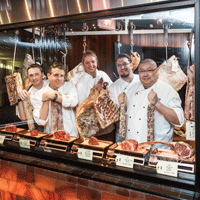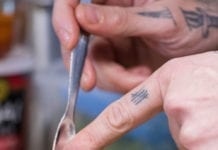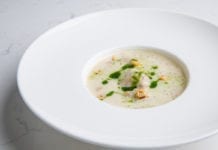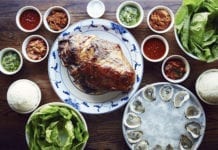While the NHL was busy locking out its players in what became a protracted and acrimonious labour dispute, the culinary team at Maple Leaf Sports + Entertainment (MLSE) was hardly standing idle; instead the brigade of 240 chefs and cooks who work behind the scenes of the NHL’s most successful franchise, had their hands full, expanding one of the industry’s hottest concepts outside the Toronto market, evolving its product offerings and introducing new concepts.
Since opening in 1999, Toronto’s Air Canada Centre (ACC) has been home to a plethora of foodservice offerings, including approximately 100 foodservice concessions, three member-driven restaurant concepts, the eminently successful Real Sports Bar & Grill (RSBG) and E11even restaurant. While the member-driven eateries (the Platinum Club, the Air Canada Club and the Hot Stove Club), charge members an annual fee to dine in their restaurants, allowing only customers with a ticket for a sports event or music concert the privilege of eating at the restaurants, RSBG and E11even are open to the general public.
Unlike Maple Leaf Gardens, where the only food fans could purchase was pizza, hotdogs and popcorn, foodservice has been an important consideration at the ACC from the get-go. Since moving from the Gardens to the ACC, MLSE has taken great attention and resources to ensure fans have real choices. But it wasn’t until three years ago that MLSE brass struck gold when it introduced RSBG, a concept that continues to draw crowds. Located in Toronto’s Maple Leaf Square, RSBG is a sports fan’s dream — a place where hockey becomes larger than life, through a massive two-storey 39-foot TV and a collection of 199 large-screen TVs scattered throughout. In fact, if you’re not lucky — or rich enough — to have a ticket to watch the Toronto Maple Leafs, it’s the next best place to be at game time. Almost overnight, the concept set a new standard for sports bars in Canada, becoming the highest-grossing restaurant, not only in Toronto but across the country.
The menu offerings are varied, not to mention more creative than most typical sports bars. In fact, the bar has scored big, garnering accolades for its made-from-scratch dishes. Then, last November, while the hockey world was crying in its beer during the hockey lockout, MLSE expanded the fledgling RSBG concept to the nation’s capital, opening its first location outside the lucrative Toronto market.
The Ottawa restaurant is located in the Byward Market, miles away from the Scotiabank Place in Kanata, Ont. “We decided to open there as it’s [an Ottawa] mecca for great restaurants,” explains Robert Bartley, senior director of Food and Beverage and executive chef, MLSE. The thinking was “we would still get good business on hockey nights, but we would also pick up the lunch crowd, the dinner crowd. Where we really think we’ll have a good run is in the summertime, because that’s when everyone comes down to the Byward Market,” says the 44-year-old chef.
Before taking the concept east, the company conducted a great deal of market research, scouting Ontario sites in London, Vaughan and Mississauga. At 14,000 square feet, the restaurant is smaller than its Toronto cousin, which is almost double the size, at 25,000 square feet. That said, “If you take the layout of the RSBG in Toronto, it would be the exact same thing,” says the Stratford Chefs’ School graduate, who once was the top toque at the Four Seasons Toronto.
But building the Ottawa restaurant posed some unique architectural challenges, admits Bartley. “The space we chose once housed two floors of retail. In order to make the space fit for RSBG we needed to convert those two separate floors into one space joined by two staircases. We also “cut out” a large semi-circle (roughly 1,000 square feet) of concrete slab to accommodate the two-storey 27-foot TV screen and fit the overall “look” of RSBG. To do this we needed to re-route the base building electrical, mechanical and plumbing — an ominous task to say the least.”
The core of the menu remains intact, but several dishes were removed for the Ottawa unit. Average menu prices range from $19 to $20 at lunch and $23 to $27 at dinner. The Ottawa culinary team is helmed by GM Matt Valentine, and chef Carl Baptista, another Four Seasons’ alumnus. Tony Glitz, executive chef of Toronto’s RSBG along with Bartley, commute between the two cities to oversee the menu development.
While there are plans afoot to continue the expansion, they’re being scrutinized by MLSE’s new owners (Rogers Communications and Bell Canada). “We haven’t found any sites yet that we are aggressively going after. We’re not on a pause, but we are waiting to find out whether our owners are in line with what we want to do,” says Bartley.
When the time does come to add more units, Bartley says Calgary and Edmonton are considerations. “We have two different tier levels, where we go big-market level, where it’s not based around an NHL city, so that could be [Ontario’s] Mississauga, London, Barrie — places like that. Or we could go premium tier, where it’s based around hockey arenas such as Calgary and Edmonton.” Bartley adds that expansion in the U.S. is also possible, with cities such as Chicago, Pittsburgh and Las Vegas being considered.
Closer to home, MLSE recently took over the F&B at Toronto’s Ricoh Coliseum. “It’s a whole other stadium, much smaller, but it is still a stadium,” stresses Bartley. “That’s part of our growth strategy. We checked that box now.” MLSE also runs F&B at Toronto’s BMO Field where “We will continue to expand our menu offerings this year with the addition of a butter chicken hotdog and a Señor Hotdog, a Mexican-inspired hotdog, pulled-pork, beef brisket and carved porchetta.”
Certainly, last year’s lockout impacted sales at MLSE as well as other downtown restaurants, but Bartley says having other sports teams in Toronto (the Raptors, the Blue Jays and the Argos) helped soften the blow. “Real Sports has always been brand agnostic and sports agnostic. We have people who come in and watch football, so we had a great football run; we had a great baseball run with the World Series, basketball … and we’ve had concerts, so we haven’t been slow. Were we as intense as when hockey’s here. No,” he states.
The effects of the strike were felt. “We become more efficient when we have all systems firing. So, it’s harder on us when it’s not. You don’t have the revenue coming in, so you’re watching everything. And you’re working with fewer tools,” says Bartley. Unfortunately, the lockout affected staff. “We didn’t lay people off, but we did reduce their hours,” he says. “They had to pay the rent, so some did leave.”
In between the drama, the company also renovated its members-only Hot Stove Club. “We really wanted to bring back the lustre and charm of what the Hot Stove was back in the Gardens, so we titled the project ‘Revitalization of a Legend.’ It’s a modern reinterpretation on that exclusive atmosphere, and the premium offerings are no different than what we offer, at say, the Platinum Club, which is fine dining.”
The team opted to turn Hot Stove into a steakhouse and celebrate steaks, wine and seafood, because that’s what the fans wanted, explains Bartley, adding that the space they had to work with produced challenges. “The space zig zags and has low ceilings,” he explains. “From a design standpoint, it was a challenge to make a really cool-looking space, given that footprint.”
Local designer Fleur de Lis helped the team overcome that challenge. “It goes back to 1970s glam. It’s got a cosiness to it, it’s got a comfort level, it’s got nice finishes to it. But it doesn’t feel like you’re coming into an ultra-glam dining space,” says Bartley. With 204 seats, it’s bigger than the original by 60 seats. “It’s a modernized version of what it was. We kept some of the elements from the old, but having dry-aged steaks on show at the entrance, right away you know you’re walking into a steakhouse. And having the seafood counter designed and built in the middle of the dining room gives our guests a visual of the menu.” With 300 members, the club is helmed by Kyrn Stein, chef de cuisine.
Unlike RSBG and E11even, the Hot Stove is only open during hockey games. “We tried to open it during basketball games about five years ago, but it failed miserably,” explains Bartley, who alludes to further changes in the coming months. “It’s different demographics, and it was always branded as a Leaf club. So this year, we opened it up for Raptors games, as long as you have a ticket to get in.”
Meanwhile, changes haven’t been restricted solely to MLSE’s restaurants. “We’ve added a Hero Burger concept in the Air Canada Centre. It seemed like a right fit for us; it’s a local brand,” says Bartley. “And, we’ve had to change Burkie’s Dog House; it’s just the Dog House now,” quips the chef, referring to the changes necessitated by the firing of Maple Leafs’ GM Brian Burke earlier this year.
Additionally, MLSE introduced oysters on the “half shell” to the 100 level and the Platinum suites area. “We’re starting to see some pick up. We have more than 100 different menu items in our concessions, but it takes time for people to get to know the menu. We came up with a menu guide, showing people what the options are, whether you’re health-conscious or want specialty items.”
MLSE is using social media to help fans understand the options, from fruit cups to pizza, chicken fingers and hotdogs. The culinary team is in the throes of researching steam buns, roasted pork and more hand-held vegs. “We’re always trying to recreate new concepts and looking at other stadiums to see what they’re doing,” says Bartley.
The formula is working. MLSE has been ranked as one of the top 15 stadiums in North America. “We’re considered leaders in the industry, and the biggest difference is we’re self-operated. Ninety per cent of everything else out there is third-party in almost every arena. That’s part of our distinctive difference.”
Still, despite the success, Bartley isn’t resting on his laurels. The chef alludes to more changes to come. “We’re looking at a potential expansion at [Toronto’s] BMO Field, with modification of the offerings we do there. It’s a city-owned property, so we have to work in conjunction with them. There’s some exciting stuff to come.”
And, who knows, with the real possibility of the Leafs making the playoffs for the first time in almost 10 years, there just may be more than one winning team at MLSE.
image courtesy of Chrtistopher Dew




![Redberry Restaurants Becomes Canada’s Area Director for Jersey Mike’s Subs Expansion Redberry Jersey Mike’s Subs - Paul Pascal (left), director of Operations, and Stephen Scarrow (right), senior Marketing manager]](https://www.foodserviceandhospitality.com/wp-content/uploads/2024/04/Redberry-Appointments-218x150.jpg)
















